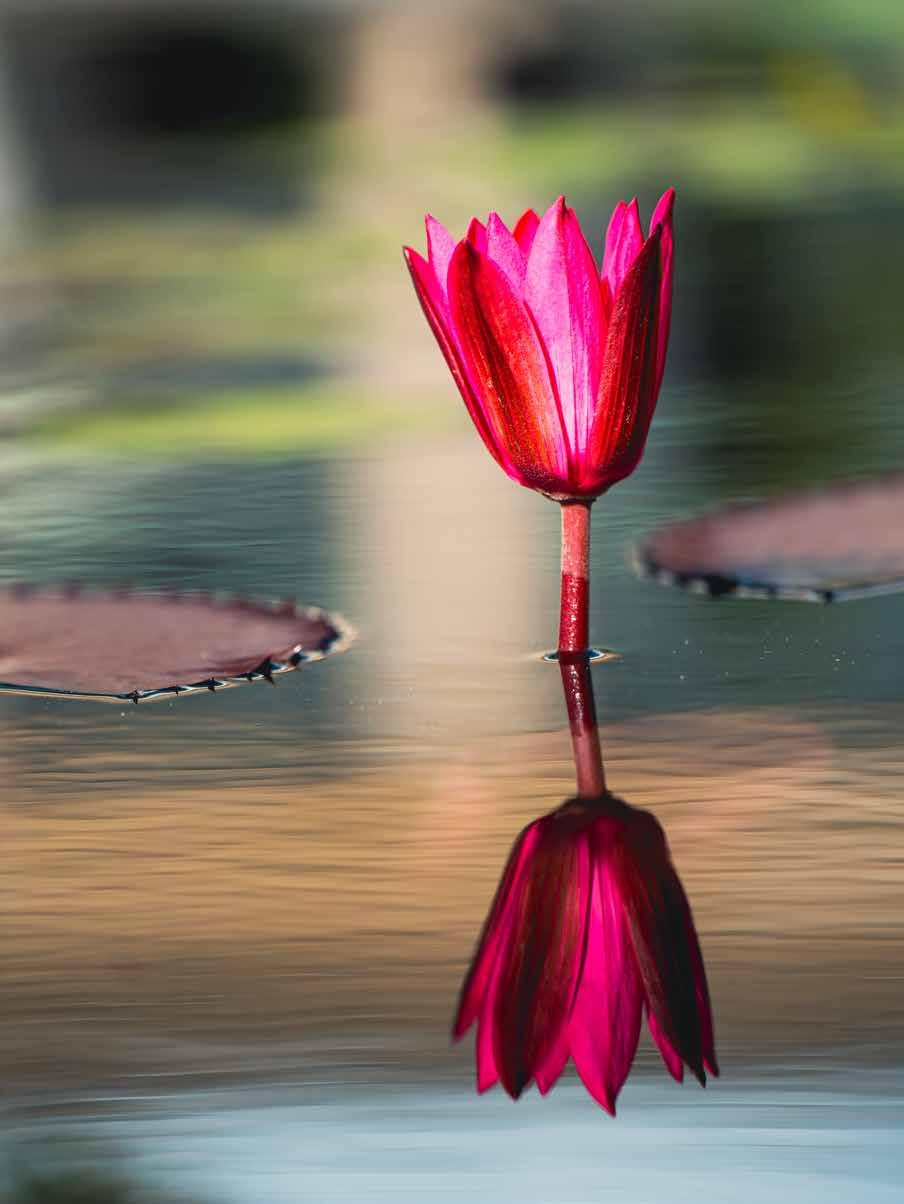

LONGWOOD CHIMES 311

Features
Water is the lifeblood of any garden, shaping landscapes, sustaining plant life, and creating tranquil spaces—and moments of wow—for guests to enjoy. In this issue, we explore the many ways water is used at Longwood—both as a practical necessity and a source of beauty. From our sustainable practices to manage and to conserve water throughout our property, to the triumphant return of our much-loved Waterlily Court, to the unique role water plays as an esthetic element throughout our Gardens. We hope these stories deepen your appreciation for the vital role water plays in our Gardens and our enduring commitment to its thoughtful stewardship. Our work is far from finished, and we welcome your support. You can have a meaningful role to play in what comes next. Every gift—no matter the size—helps us protect and elevate this precious resource for future generations. Water sustains not only our landscapes, but the very spirit of Longwood.
6
One Water
Our ever-evolving approach to sustainable water management. By Paul Stratman
28
Fun Fountain Facts
A fount of Longwood fountain facts to keep you in the cool for the warm summer months ahead.
By Patricia Evans
12
The Medium is the Message
The water-centric West Conservatory is the ideal setting for a watercolor workshop.
By Katie Testa
30
A Triumphant Return
Our Waterlily Court makes its grand return—and serves as the culmination of Longwood Reimagined By Katie Mobley End Notes
50 For the Love of Books
A generous gift to our new Library in memory of Longwood Volunteer Mary Zwiebel. By Katie Mobley
16
The Art of Water Our Gardens are overflowing with artistic, unexpected, and sometimes overlooked water features just waiting to be discovered.
By Kelli Stewart
36
Tea with Monet
Pierre and Alice du Pont visited La Belle France in 1925 to experience private châteaux and gardens, including a tour around Claude Monet’s picturesque waterlily garden. By Colvin Randall
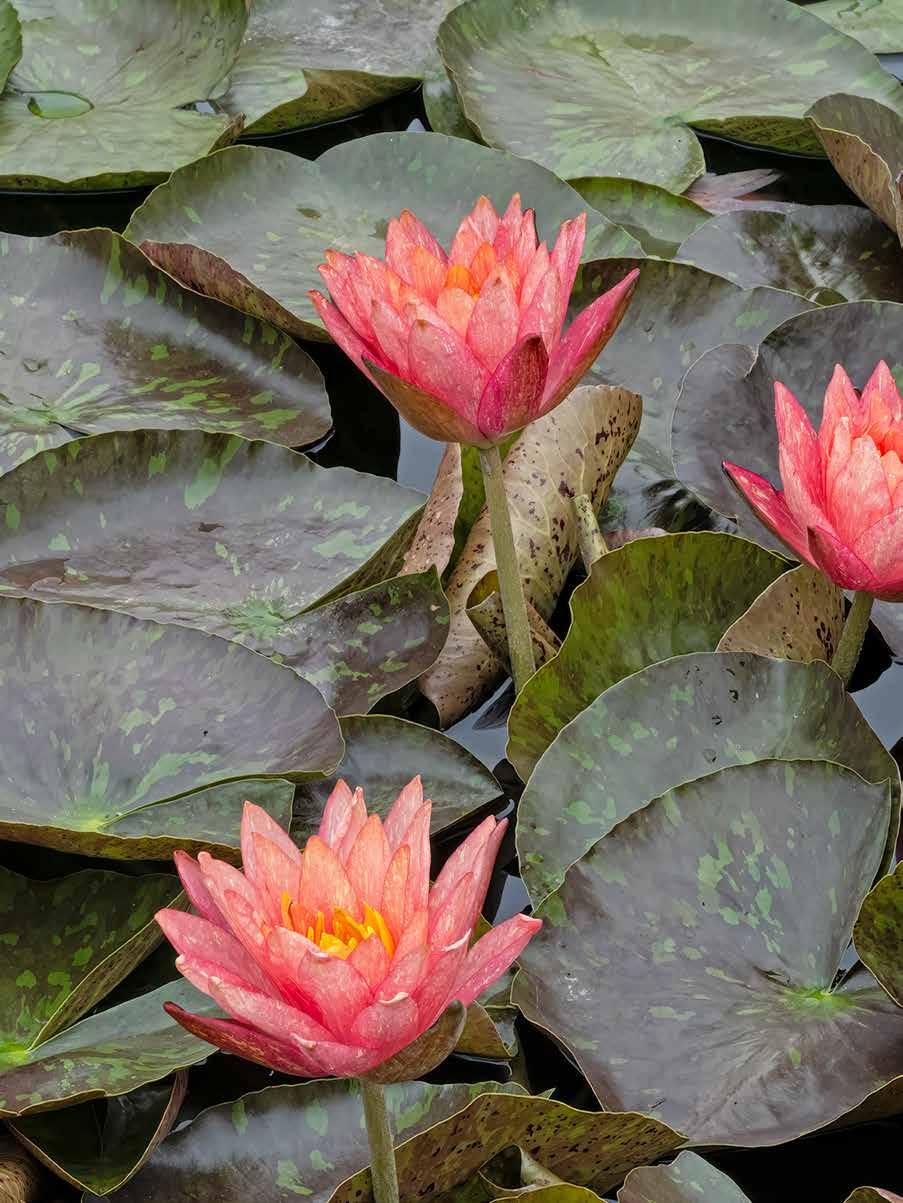

Nymphaea ‘Wanvisa’ hardy waterlily on display in the Waterlily Court. Photo by David Ward.


WATER ONE
Our
approach
to sustainable water management.
By Paul Stratman
From our stormwater management practices, to our support of healthy waterways, to our thoughtful and thorough approach to sustainability with Longwood Reimagined, water—and the responsible conservation of this resource—is vital at Longwood.
We depend on water throughout our conservatories, landscaping, and displays— as well as for our world-class fountain shows, onsite restaurants, and the domestic water services required by the 1.6+ million guests that visit us each year. Water is also crucial for our “back-of-house” operations that include offices and workspaces for nearly 800 full- and part-time staff, onsite staff and student housing, greenhouses large and small, and acres of outdoor plant and nursery growing spaces.
Historically all of our water came directly from onsite groundwater wells. That water was pumped from the ground, utilized for its intended purpose and whatever wasn’t directly consumed or lost to evapotranspiration and infiltration made its way to surface water features and eventually left the Longwood Gardens watershed.
As we have grown over the past 50 years and attendance has increased, so too has our demand for water. Fortunately, along with that growth, we anticipated the increasing demand for water and importance of protecting our groundwater resources.
Since 1985 we have been developing and implementing measures to manage all types of water (including potable water, wastewater, and irrigation water) more sustainably and responsibly. While our approach to sustainable
Photo by Daniel Traub
Photo by Hank Davis
water management did not have a formal name in 1985, and was not unique to Longwood, today an approach to water management that recognizes that all water has value and is a precious resource is commonly referred to as “One Water.”
The Longwood Gardens One Water journey began in 1985 when we decided to upgrade our onsite sewage treatment system to allow treated effluent to be sprayed on a 40-acre spray field situated on the property. By incorporating the spray field into our water management practices, we were able to begin returning water to the site instead of discharging it off-site in the creek. The spray field system came online in 1987.
In 2002 Longwood made a second significant stride along the One Water path with the design of the Garden Irrigation System (GIS). The GIS allowed treated effluent from the sewage treatment plant, which would otherwise go to the spray field, to be further treated and then used for outdoor irrigation. The GIS system came online during 2003 and since that time we have reduced our demand on groundwater for outdoor irrigation by more than 3 million gallons per year. This reduction amounts to more than 60 million gallons of groundwater savings to date!
In parallel with the recently completed Longwood Reimagined project we have taken two additional significant steps in our One Water journey.
In 2024 we completed improvements to our sewage treatment plant that allows all the water (not just water entering the GIS) to receive tertiary treatment and disinfection necessary to allow it to be used without restrictions for outdoor irrigation and other purposes. In addition, all the flush toilets associated with Longwood
…we continuously look for opportunities to reduce our overall water consumption, identify opportunities to reuse water, and strive to improve the quality of water that leaves the property.
Reimagined and new Beer Garden restrooms have dedicated plumbing systems that allow reclaimed water from the sewage treatment plant to be used for toilet flushing. The use of highly treated effluent for toilet flushing is expected to additionally reduce our dependence on potable water by approximately 1 million gallons each year.
The second step of our journey, also taken in conjunction with Longwood Reimagined, is the introduction of stormwater harvesting into our water management repertoire. Utilizing a combination of dedicated downspouts on the West conservatory and The Grove administrative building, and underground storage tanks, we are now collecting (“harvesting”) and using stormwater runoff coming from the roof tops of these structures. This practice is similar to a home gardener utilizing a rain barrel to collect water from their roof top for subsequent use in watering their garden— but on a much larger scale. For our purposes, the harvested rainwater in the tanks is introduced as makeup water into water features, used for irrigation, or sent to the flush toilets. The total groundwater savings realized through stormwater harvesting from the new West Conservatory and The Grove will be dependent on the timing, duration, intensity, and frequency of precipitation events, but initial estimates are that we will be saving on the order of 700,000 to 1 million gallons annually.
In addition to our very specific engineering measures, we are continually striving to reduce our overall water demands. For decades we have utilized the latest technologies in indoor and outdoor spaces to avoid overwatering. In 2011 Longwood partnered with UgMO Technologies to install an irrigation control system that monitors soil moisture every 10 minutes
using 168 in-ground sensors. Utilizing that information, we are able to reduce irrigation time, frequency, and water consumption. When we have an irrigation or rainfall event, we can see how the soil absorbs and subsequently releases the water. The soil sensors also monitor temperature and salinity. By monitoring soil temperatures, we know when insect or disease pressure will increase so we can make timely pest control interventions if needed. We can also reduce or extend the time fungicide applications are needed, thus reducing another unnecessary application.
Using the automated irrigation system and accessing its extremely valuable data has yielded impressive results in our goal of reducing water use. We are now able to efficiently and accurately track the irrigation and precipitation totals by location. We found that, from 2018 through 2024, we reduced annual water use in the Main Fountain Garden and in the lawn as you enter the Gardens by approximately 28 percent, without seeing a negative impact on our turf or landscape.
We have also reduced the lawn areas that are cut weekly by mowing less frequently and raising the height of the cut. Longer grass requires less water and is more droughtresistant, while reducing the number of mowings over the course of the year also reduces the associated greenhouse gas emissions.
No conversation about One Water is complete without addressing how we support healthy waterways. Six small streams flow from the Longwood property and eventually end up in the Delaware Bay. We also have over 26 acres of our property classified as “aquatic,” ranging from wetlands to ponds. To make sure that every drop of water that leaves our property is clean and can support


To date, more than 2,380 feet of riparian buffer, the area alongside streams that was historically removed for agricultural purposes, has been restored.
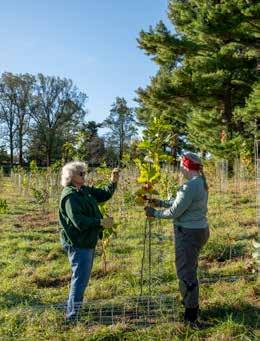

life, we pursue a wider range of actions related to surface water quality. A prime example is our reforestation and habitat restoration efforts. We plant native trees and shrubs along streams and wetlands to cool the water, filter runoff, stabilize banks, and create essential habitat for native species.
To date, more than 2,380 feet of riparian buffer, the area alongside streams that was historically removed for agricultural purposes, has been restored. Additionally, stormwater leaving the property travels through an interconnected system of basins, swales, and constructed wetlands designed to attenuate runoff and trap sediment.
Our One Water journey never ends. As we move forward, we continuously look for opportunities to reduce our overall water consumption, identify opportunities to reuse water, and strive to improve the quality of water that leaves the property. Opportunities already being pursued include:
– Implementing stormwater harvesting from our 67,700 square foot Nursery Greenhouse. This is expected to reduce our reliance on groundwater for irrigation at the greenhouse by an additional 1 to 2 million gallons annually.
– Incorporating dedicated plumbing in building upgrades, where feasible, to allow the use of reclaimed water for toilet flushing.
– Continuing long-term research related to reforestation and riparian habitat restoration and enhancement of surface water quality.
– Monitoring advances in water treatment technologies that may allow use of reclaimed water for additional purposes.
We are excited by the endless possibilities presented by our One Water journey and look forward to sharing with you every step along the way.
Land Stewardship and Ecology intern Ellen Oordt measures distance with a laser hypsometer as part of an Ecological Baseline Study Sampling at an Abbondi Wetland area. Photo by Lea Johnson.
More than 1,200 trees were planted to shade a first-order tributary of Bennett’s Run that borders one of our agriculture fields. Photo by Meghan Newberry.
Photo by Hank Davis
Education
The Medium is the Message
The water-centric West Conservatory is the ideal setting for a watercolor workshop.
By Katie Testa
Water is a vital resource not just for the health and beauty of our Gardens but for our global ecosystem as well—so it fits that one of the best mediums to capture the subtle details, colors, and textures of botanicals is watercolor paint. This past April, our new West Conservatory was the perfect venue for a watercolor workshop, with its appealing color palette, stunning textures, and warm oasis amidst the chilly, early spring weather.
The workshop was part of our extensive lineup of Continuing Education offerings, which cover topics ranging from creative and culinary arts, floral and landscape design, gardening and horticulture, to wellbeing and more.
“Longwood Gardens is a creative inspiration for so many people, stretching back to plein air painting classes in the 1950s and 60s,” shares Longwood’s Director of Continuing Education Tim Gould. “The personal connection people feel to the plants and spaces, combined with the world-class beauty curated by our horticulture team, makes for the perfect muse for painters, photographers, creative writers, and more.”
In a typical year, Longwood hosts about 75 experiences in the creative arts, welcoming roughly 900 students to unleash their creativity. No matter the subject or practice, there is something for everyone.
At the Watercolor in the West Conservatory workshop, some students were habitual artists, some were picking up a paintbrush for the first time in years, some gathered with family to spend the day together, some had never painted in their lives—and all were looking for a relaxing, immersive, and creative experience basking in the beauty of our new conservatory.
The class was led by botanical artist Diana Heitzman, who has a Bachelor of Fine Arts from Tyler School of Art in
Students gathered for our Watercolor in the West Conservatory workshop on a Tuesday, when our Gardens are closed to the public, giving them near unlimited access to our 32,000-squarefoot West Conservatory.
Philadelphia, studied at Temple University in Rome, Italy, and continued her education in graphic design and advertising at Moore College of Art in Philadelphia. When asked about what makes teaching in a garden setting like Longwood so enjoyable, Heitzman says, “Everyone is so appreciative … they are all inspired by plants and have the same interests. Studying flowers, you learn so much. You’re on site with horticulturists and everyone is so helpful.”
“Heitzman is a top-notch botanical artist and instructor,” says Gould. She studied with former Longwood botanical art instructors before beginning to teach at the Gardens in 2021. She is involved in the American Society of Botanical Artists and the Philadelphia Society of Botanical Illustrators and has exhibited at the Philadelphia Flower Show for over 20 years. At Longwood, Heitzman teaches a mix of botanical art study and painting classes en plein air—meaning “in the open air” in French—where students are out in nature capturing what they see in real time.
Botanical art, unlike the freeform plein air style, can be very technical—like a science itself. Much like a horticulturist studies a plant and its different parts, so does a botanical artist. In her own practice, Heitzman uses watercolor as her medium of choice.
Heitzman always starts her pieces with a light pencil sketch of the subject. To begin the painting process, she first adds water directly to the paper, followed by light applications of pigment. This is so the paint goes exactly where she’d like it to go while also creating a soft, smooth effect. Traditionally, botanical art pieces have a white background and the light source is positioned to the upper left side of the subject—so, precise color placement is key.
Botanical artwork is meant to capture the essence of a plant, not a singular,
Photography by Meghan Newberry
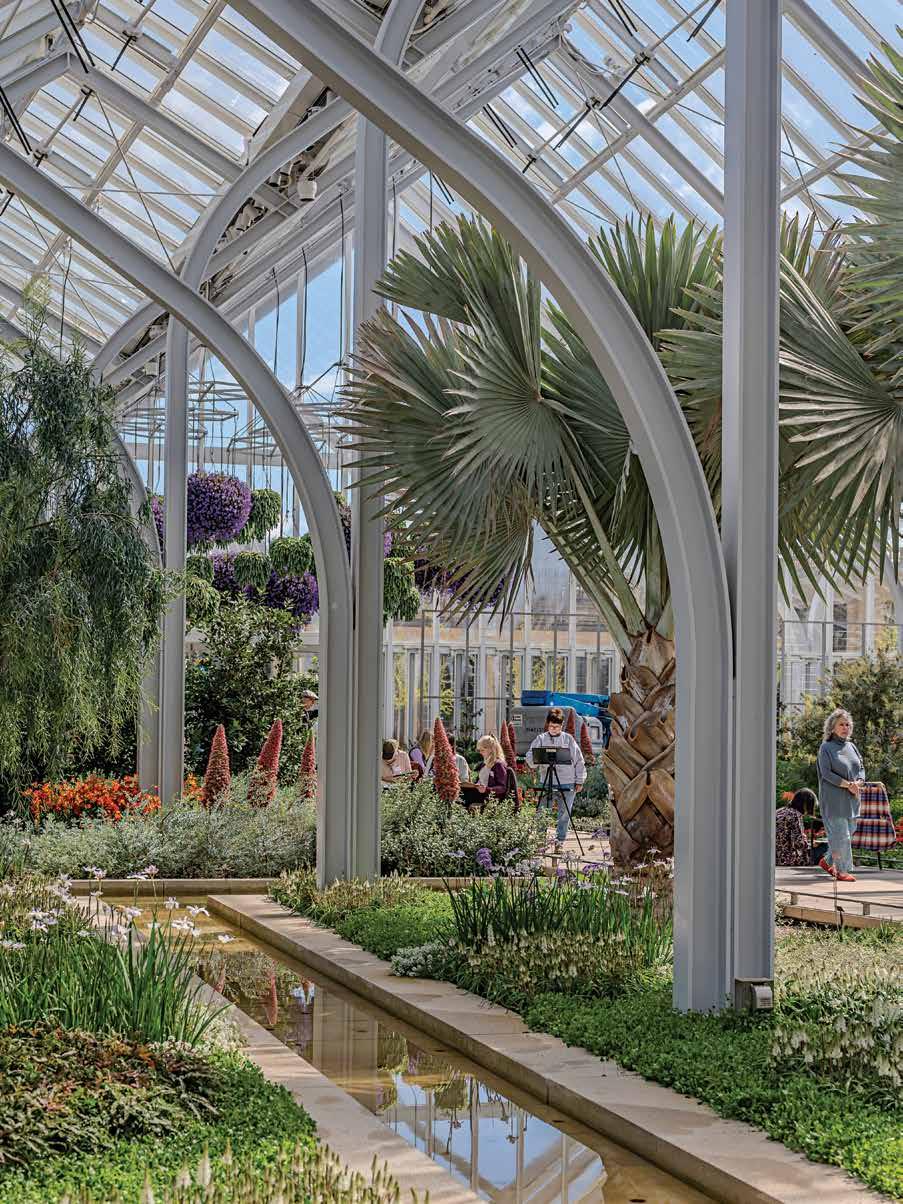
still-life subject. In addition to blossoms, botanical artists often illustrate all phases of a plant species, including roots, leaves and seeds. These are then composed into a single painting. “But you have to capture the blooms first,” says Heitzman. “Because that part of the plant is the first to fade.”
Heitzman’s pieces range from scenes of lush natural beauty to meticulously detailed botanical art pieces. Heitzman found inspiration in even the smallest bits of living beauty in cities—from flowers growing in townhouse window boxes to greenery in parks and community gardens.
While living in Philadelphia, she would often venture out to Longwood in the evenings to unwind, breathe in nature, sketch, and paint. “It’s relaxing to sit outside and sketch what you see,” says Heitzman. “There is a meditative quality to it.”
“You’re never bored out in nature,” Heitzman says. “There’s always something to be inspired by.”
Next time you’re in the Gardens … or out in your backyard or home garden … or taking a walk in your community … or even tending to your indoor plants, pick up a sketchbook and observe the shapes, textures, and pigments of plants. Through an artist’s lens, you might discover something new about plant life that you never would have noticed before. Try your hand at watercolor, and see how water helps to capture the true, unique nature of botanicals.
Interested in taking a class in our Gardens? You can see our complete lineup of upcoming courses at longwoodgardens.org/enroll

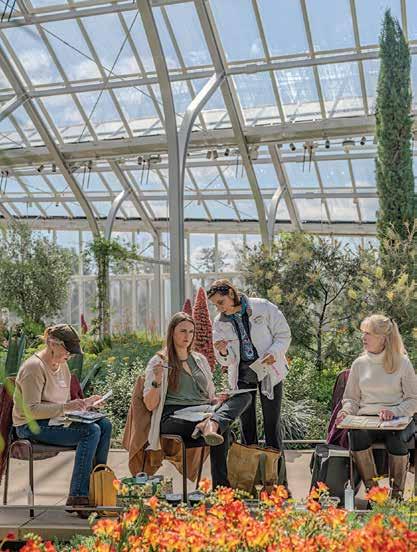
Continuing Education students met on a Tuesday, when our Gardens are closed to the public, for our Watercolor in the West Conservatory workshop. The spacious and beautiful Mediterranean-themed garden provides a contemplative setting for painting, sketching, and nature study.




Instructor Diana Heitzman gave personalized advice to each student, guiding them in their watercolor journey.
THE ART OF WATER
Our Gardens are overflowing with artistic, unexpected, and sometimes overlooked water features just waiting to be discovered.
Text by Kelli Stewart


Carved limestone and terra-cotta ornaments impart an Old World feeling with spouting, gushing, and dripping streams along this wall tucked beneath the Italian Water Garden overlook (see previous page).
At the southwest corner is a unique water staircase where it is said that Pierre du Pont once posed his young nieces and nephews on the dry steps for a photo then drenched them with cascading water much to everyone’s delight. A nearby rustic waterfall (opposite) and two small side cascades are supplied from the Sylvan Fountain in Peirce’s Park as its water returns to the Italian Water Garden pump house to be recirculated. Photos this spread and previous by Hank Davis.
An Old WorldInspired Wonder Italian Water Garden

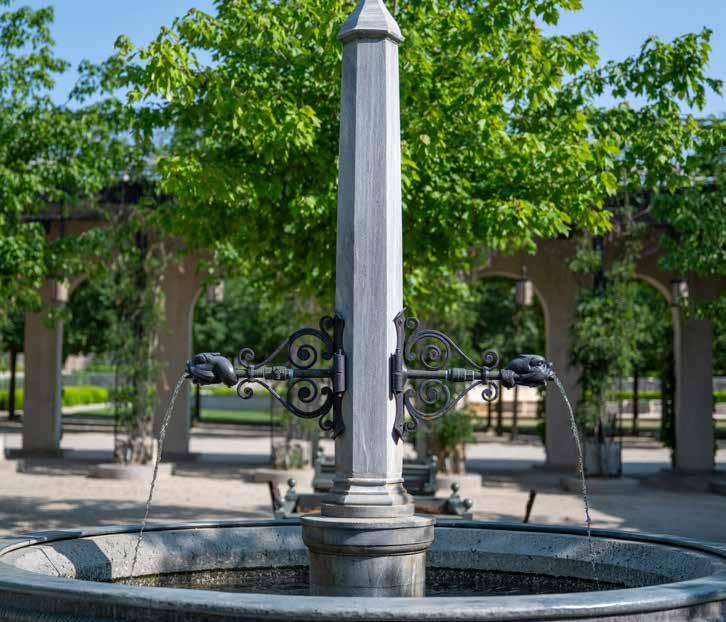

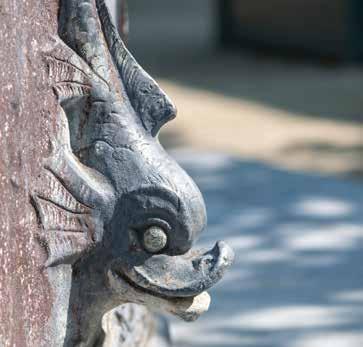
Originally purchased in 1931, the lead fountain now in the Pumphouse Plaza was a trial enclosure for the fountain basins that Pierre planned for his Main Fountain Garden. Though he ultimately pivoted away from lead, this basin was placed in the Main Fountain Garden and fitted with spouts and dipper cups for guests’ refreshment. With its classical motifs including dolphins, berries, and gargoyle masks, it echoes the style found on stonework across the gardens. No longer a drinking fountain, it now anchors Pumphouse Plaza and offers a focal point for guests exploring the Pumphouse Museum, Conifer Knoll, and the Idea Garden. Photos by Hank Davis.
A Refreshing Respite Pumphouse Plaza Fountain
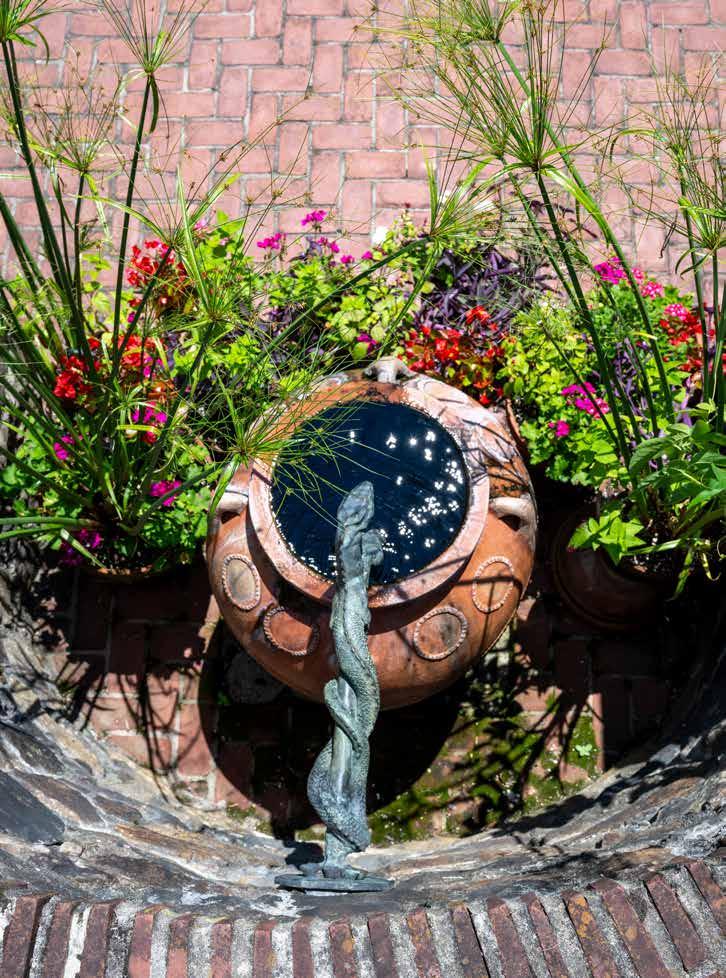
Accomplished artist Nancy du Pont Reynolds Cooch was a longtime member of Longwood Gardens’ Advisory Committee. Although Mrs. Cooch worked across multiple media, she was known best for her sculpture, including this fountainhead that she donated in 1978. Since then, this friendly sea serpent drip fountain has entwined itself in a niche adjacent to the Square Fountain near Flower Garden Walk: a subtle touch of whimsy that surely would have been appreciated by Pierre and Alice.
Photo by Hank Davis.
A Serpentine Discovery Serpent into the Urn Fountain

Featuring four dolphins, a classical motif common in Pierre’s and Alice’s garden ornament, the lead fountain basin that sits outside the Rose Garden was purchased for $379 in 1939 from Kenneth Lynch & Sons, then of Long Island City, New York and still operational now in Oxford, Connecticut. No longer a drinking fountain, as it was first intended, it still serves as a landmark at the entrance to the Rose Garden, where its gentle water sounds beckon guests to enjoy the floral display. Photo by Daniel Traub.
A Rose by Any Other Name Rose Garden Fountain
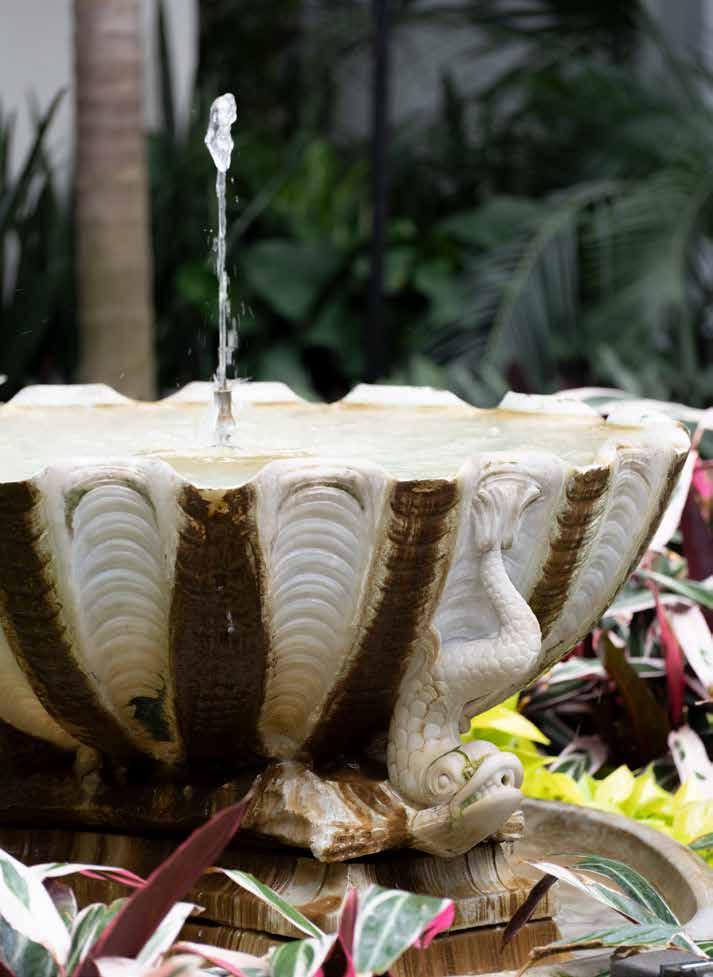
Celebrating the 1914 wedding of Pierre and Alice, the diminutive and delightful dolphin fountain in the conservatory of the Peirce-du Pont House was a gift from Pierre’s oldest sister, Louisa Copeland, and her husband. The hemispheric shellshaped basin now features a central jet of water and sits atop a base supplied by A. Olivotti & Co. of Florence, Italy, the same firm that would later help Pierre create the stonework of the Main Fountain Garden. Photo by Daniel Traub.
A Wedding Present Dolphin Fountain

Drink in the Details
Exhibition Hall
Drinking Fountain
Tucked around the corner from the Orangery, this easily overlooked fountain was constructed with an attention to detail that characterized all of Pierre and Alice’s projects. Its red and green floriform design typifies the polychrome mosaic concrete of John J. Earley (1881–1945), an artisan particularly chosen by Pierre to apply his innovative techniques with concrete aggregate throughout the conservatory.
Photo by Steve Fenton.

A Rare Find East Conservatory
Blue Granite Fountain
Formed out of rare blue Brazilian granite, the Blue Basin was introduced as part of the East Conservatory renovation of 2004. Custom designed for the space, it was part of a constellation of water features intended to offer moments of discovery to guests as they move through the indoor garden. The cool tones of this special stone echo the colors in the Encephalartos lehmanii, planted just behind the fountain to gently overhang it. Photo by Hank Davis.

A Symbolic Source Eye of Water
Modeled after a water feature of the same name in San Antonia de Belen, Costa Rica, the Eye of Water was installed in 1968 under the supervision of Dr. Russell J. Seibert, the first director of Longwood Gardens after Pierre du Pont’s death. Before making its gravitational journey toward the Waterfall, water is pumped to this high point of Conifer Knoll, where thousands of gallons pass through the “eye” each minute. Surrounded by a Japanese-inspired pavilion designed by Wilmington, Delaware architects Victorine & Samuel Homsey, the water feature offers a moment of contemplation and shelter to guests exploring the southern edge of the Gardens. Photo by Hank Davis.
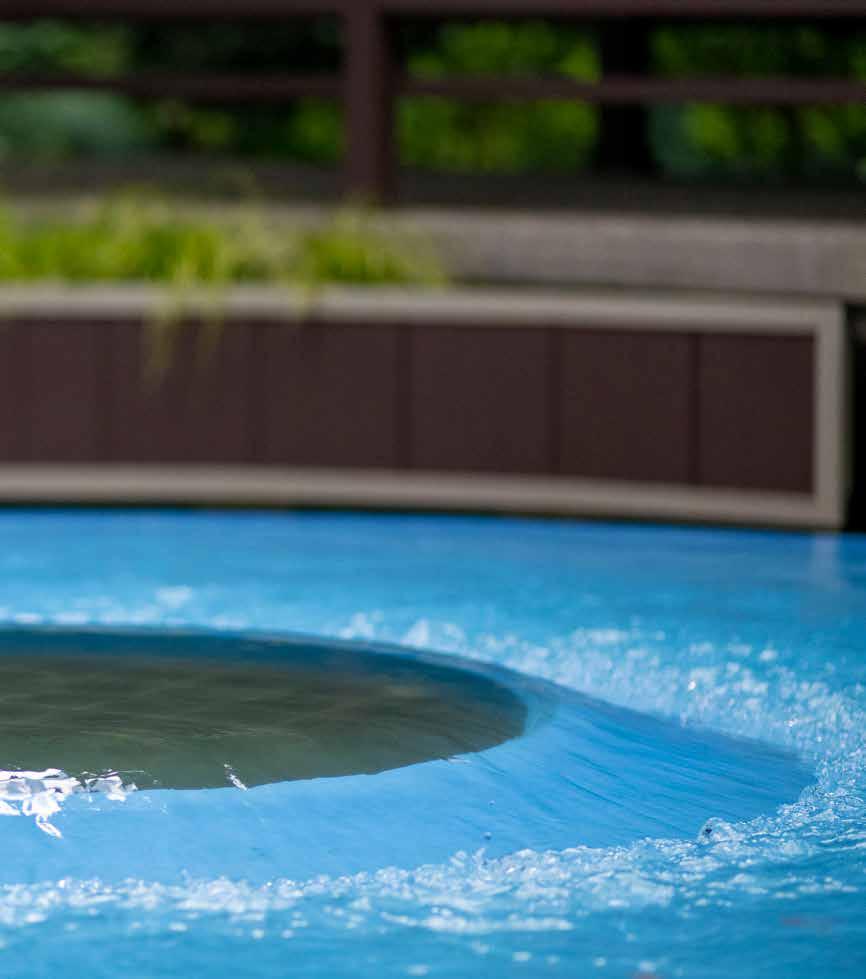

3. Round Fountain
1. Italian Water Garden
2. Sylvan Fountain
4. Open Air Theatre

A Fount of Fountains Home to one of the most significant fountain collections in the world, Longwood Gardens includes two fountain gardens that are illuminated and set to music (our Main Fountain Garden and our Open Air Theatre). Collected here are some other fun and interesting facts about our unique fountains and water features.
9. Basketweave Fountain Developed exclusively for Longwood, our 30 Basketweave fountains found in the Main Fountain Garden are the result of 40 small jets angled to create an effect reminiscent of a circular sheaf of wheat.
8. Flame Nozzles The 30 flame nozzles in the Main Fountain Garden are a bit of an engineering marvel … a stream of propane ignites into a foot-high flame atop a 10-foot tall water jet to create a dazzling effect.
7. Children’s Garden Water fun abounds in the Children’s Garden where 130 jets, 12 popping jets, five laminar jets, four bell jars, one drooling dragon, three dripping snakes, two bubblers, one wall spout, three waterfalls, and two rain curtains delight our youngest guests.
6. Main Fountain Garden Our largest fountain Garden features 1,719 jets, with the tallest jet reaching 175 feet. The garden features 141 fountain effects in all.
5. West Conservatory Our newest conservatory features 30 low jets and 30 bubblers. The bubblers are designed to emulate rain drops on the water surface, making expanding ripples on the surface.
3. Round Fountain Located on Flower Garden Walk, Longwood’s first fountain features a single jet and was turned on in 1907.
4. Open Air Theatre Mr. du Pont’s first foray into a fountain garden, the Open Air Theatre features 750 jets, including a water curtain that can reach up to 10 feet tall.
2. Sylvan Fountain Located in Peirce’s Woods, the Sylvan Fountain features five jets, with the center jet reaching up to 40 feet tall. The water from the fountain disappears underground, only to reappear at the Italian Water Garden, cascading down a small waterfall into two rustic pools.
1. Italian Water Garden Designed by Mr. du Pont, the rear two rectangular pools of this garden are actually 14 feet longer than the front two pools. Known as forced perspective, this design approach tricks the eye into thinking the pools are all the same size when viewed from the overlook.
Illustration by Nolan Pelletier
5. West Conservatory 8. Flame Nozzle
9. Basketweave Fountain
7. Children’s Garden
Main Fountain Garden
A TRIUMPHANT RETURN

Our Waterlily Court makes its grand return—and serves as the culmination of Longwood Reimagined.
By Katie Mobley
Photo by Holden Barnes



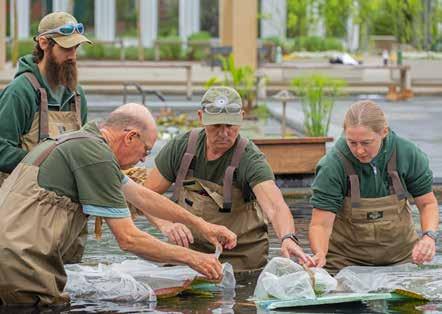
Above: Drone’s-eye view of the enhanced Waterlily Court. Note the outdoor room effect created by the new covered arcade. Photo by Carol Gross.
Above: Nymphaea ‘Aquarius’ tropical day-blooming waterlily (foreground) and Victoria cruziana Santa Cruz waterplatter in the production greenhouse in preparation for transfer to the Waterlily Court. Photo by Carol Gross.
Above: (left to right) Horticulturist Assistant Cory Braddy, Horticultural Specialty Grower Tim Jennings, Horticulturist Rick Fountas, and Senior Horticulturist Suzanne Boom install a Victoria water-platter in the Waterlily Court. Photo by Daniel Traub.
Originally opened in 1957, re-envisioned by landscape architect Sir Peter Shepheard in 1989, and now reimagined and reopened as of May 9, 2025, our beloved Waterlily Court is an aquatic showcase like no other. Making its dazzling return just in time for the beginning of aquatics season, this iconic space is once again wowing our guests with its spectacular aquatic treasures and luminous blooms … and with Shepheard’s vision beautifully honored.
Our renewed and enhanced Waterlily Court has been redefined as an outdoor room and further strengthened as a central destination and as a gateway to our new West Conservatory. Framed with a new covered arcade to the north and west, the peaked roofline of the new West Conservatory is visible beyond. The redefined outdoor room now features new granite tiles and tiered steps into the space, artfully adorned with planted containers that further elevate the beauty. Numerous improvements to the Waterlily Court’s infrastructure have been made, including new plumbing to improve the water circulation, enhance controls, and increase the water quality in its six pools. We improved the water heating capacity to further support plant health and added new
lighting to help illuminate the intricacy of our aquatic plants’ beauty.
At long last, this elegant garden stuns with its six quiet pools, showcasing a diverse, masterfully curated array of aquatic plants from around the globe and hybrids developed at our Gardens. Here, in this seasonal showcase, nearly 100 varieties of vibrant hardy and tropical waterlily specimens quietly float alongside captivating lotus, towering aquatic cannas, and sprawling South American water-platters.
This spectacular seasonal display is a true testament of how varied—and vast— our waterlily (Nymphaea) collection is … and one that is continuing to grow, with additions from as far away as Tanzania, just this year. Accredited as one of the best waterlily collections in the United States by the Plant Collections Network, our collection consists of some of the finest tropical and hardy waterlily hybrids produced by the most noteworthy breeders—and the Waterlily Court is a true celebration of our collection’s significance.
As in prior years, our verdant Victoria ‘Longwood Hybrid’ water-platters made their return to the Waterlily Court pools in late May, as we must wait to place these
aquatic plants in warmer water. These spectacular plants—with leaves as large as 6 feet across—glide to and fro in the pools during the warm-weather months.
Longwood is a leader in the field of growing and displaying water-platters in a public garden setting. Beginning in the 1950s, we began growing Victoria amazonica, native to Guyana and the Amazon River basin, and Victoria cruziana, native to the Panama River in northern Argentina, Paraguay, and Bolivia. A hybrid cross between Victoria amazonica and Victoria cruziana called ‘Longwood Hybrid’ was developed at Longwood Gardens by Waterlily Hall of Fame inductee and Longwood staff member Patrick Nutt in 1960, and first flowered at Longwood Gardens in 1961.
Although Victoria are perennial plants native to South America, in our climate they are treated as annuals and complete their entire life cycle in less than one year. Each year, our aquatic experts handpollinate the flowers to generate a new crop of seeds for the next season’s display, as well as distribute seeds to horticultural institutions around the world … resulting in not only the sharing of seed that is not
Tim Jennings,
Assistant Cory Braddy, Senior Horticulturist Suzanne Boom, Horticulturist Rick Fountas, and Professional
Student Katie Overman pause for a group portrait in the central pool of the Waterlily Court. The platter-like leaves of the Victoria waterlily are temporarily covered with a fabric material designed to prevent sun overexposure during the interim acclimation period.

Right: (left to right) Horticultural Specialty Grower
Horticulturist
Horticulture
Photo by Daniel Traub.


readily available commercially, but allowing for even more public garden visitors worldwide to experience the beauty of Victoria
During the time the Waterlily Court was being refreshed, we continued to grow and maintain the aquatic plants for which this space is known—including our famed Victoria water-platters. A collaborative agreement between Longwood and Naples Botanical Garden in Florida, and under the leadership of Longwood Horticultural Specialty Grower Tim Jennings, supported the growth and future of Victoria throughout the Longwood Reimagined project by continuing the seed production of V. amazonica, V. cruziana, and their resulting Victoria ‘Longwood Hybrid’ while the Waterlily Court was undergoing revitalization—as detailed in Going the Distance in issue 303 of Chimes. Through this collaboration, which served as the first time we entered an agreement with another institution to grow Victoria seed for us, we were able to maintain a source of viable seed. During that time, we also grew some Victoria here at Longwood to help protect against unforeseen interruptions by Mother Nature—such as a hurricane, which did end up occurring in Naples during that time—that may have impeded their growth in Florida.
Our collaboration with Naples Botanical Garden serves as a fantastic opportunity to observe seed production in a new setting with a longer growing season—which translates into an opportunity to ensure these magnificent plants grow and thrive at gardens around the world. Now, with the Waterlily Court’s return, Longwood guests can once again experience their beauty firsthand.
Upon its return, our refreshed Waterlily Court also showcased the resulting beauty of another groundbreaking Longwood initiative—our ever-evolving plant exploration program, which supports a network of plant conservation and research programs around the world—and helps contribute to displays here at Longwood.
While our plant exploration efforts span the globe, recent intensive work in Tanzania has been a priority as we seek to expand our conservation efforts into the tropics, impact international conservation efforts, and add to our orchid and waterlily collections. In support of our efforts, Longwood’s Director of Conservation Horticulture & Collections Peter Zale, Ph.D. has traveled to Tanzania three times since 2023. Recently, Zale has been working closely with our partners in Tanzania to survey one of three yellow waterlilies found in the wild there—Nymphaea stuhlmannii
Endemic to a 20-square-mile area in central Tanzania, N. stuhlmannii is very rare in the wild, and must contend with several factors for survival—from much of its natural habitat being converted to rice plantations, to hippos and elephants being known to graze on its foliage. This species has not been cultivated for nearly 100 years—but, through our plant exploration program and work with our partners, we have been able to import its tubers to Longwood. Using these tubers, we’ve learned its cultural requirements and used flowering plants to successfully hand-pollinate the flowers to germinate seeds, in order to grow more plants—all to help conserve N. stuhlmannii ex situ and help protect it.
Now, the luminous yellow blooms of N. stuhlmannii are not only found in central Tanzania—they can be enjoyed in our very own Waterlily Court, and their seeds are in our conservation seedbank. As our research to better understand them progresses, we will continue to conserve this rare species for generations to come.
The reopening of our Waterlily Court brings with it countless opportunities to behold not only beauty, but decades upon decades of concentrated efforts to conserve, to share, to dazzle … and we are delighted to showcase the beautiful results, once again, with you.
Above, left to right: Director of Conservation Horticulture & Collections Peter Zale, Ph.D. and Lourance Mapunda at a site in Tanzania where Nymphaea stuhlmannii is native; Nymphaea stuhlmannii growing in the wild in Tanzania. Photos courtesy of Peter Zale.
Opposite: Nymphaea stuhlmannii in the production greenhouse pools at Longwood in 2024. Photo by David Ward.

Tea with Monet
One hundred years ago this summer, Pierre and Alice du Pont visited La Belle France to experience private châteaux and gardens reflecting centuries of architectural and landscape splendor, including a tour around Claude Monet’s garden led by the master Impressionist himself.
By Colvin Randall
One hundred years ago this July, Pierre and Alice du Pont took a monumental tour of France to explore some of the best gardens that country had to offer. They both had visited there previously, but never to the degree afforded by this trip, sponsored by the Garden Club of America. Joining them was Pierre’s sister Louisa Copeland, her husband Charles, their son Lammot, and family cousin Aileen M. du Pont.
Pierre and party sailed from New York on June 24 on the SS Mauretania. Louisa reported on a most pleasant crossing: …we left New York in a large shower of candy, flowers, books, etc. … Alice and Pierre had seventy six presents sent them. The voyage across was like a continuous afternoon tea … The ocean, the entire way, was like a mill pond, so there was a dance every night, and generally much merriment.
Pierre had arranged for two fivepassenger closed cars (General Motors Cadillacs, of course) to pick everyone up at Cherbourg to drive them to Rouen for the night, then on to Bourges for another night, then finally to Bourg-en-Bresse (270 miles southeast of Paris) where they settled in at the Hotel de l’Europe so they could explore the Belin ancestral roots in and around the Château d’Andelot, about 23 miles north of Bourg. Pierre with Alice’s brother F. Lammot Belin had purchased it
in December 1924. Constructed around 1158 by the Coligny family, it was eventually confiscated by the King because the Colignys were Protestant Huguenots. The château was not returned until 1617. In 1702 it was sold to the Guyénard d’Andelot family, whose descendant and immigrant Henri-Victor Guyénard d’Andelot (1769–1813) of Philadelphia inherited it. His daughter Isabella had married Henry Hedrick Belin—thus Henri-Victor was Pierre, Alice, and F. Lammot Belin’s greatgrandfather. In 1827, the family sold the property and eventually it was sold again, until finally Pierre and F. Lammot bought it back in 1924 for $8,100. This was Pierre’s first visit as co-owner, although he and Alice had seen it briefly in 1913.
Louisa d’Andelot Copeland recounted the “adventure,” which it truly was since the château was not yet habitable to du Pont standards: Two cars met us at Cherbourg, and we motored across France to Bourg. A most comfortable old fashioned hotel at Bourg, where you could watch the dinner being prepared in the kitchen, and all the provisions came in the front door. We stayed there a week while we played with the château d’Andelot. Each day we went to Andelot and had a picnic lunch there. It takes quite a while to get acquainted with a place, and get it cleared up in your mind, to see what has to be done.
They took many snapshots and collected postcards along the way as they visited towns and castles in the vicinity of Andelot. Pierre was no doubt interested in seeing how a château could be restored since he now co-owned one. From Andelot, the group drove one day to Dijon for an overnight stay. The next day they drove about 155 miles to Fontainebleau, passing through or near other towns that were historically important to the du Ponts, including Chevannes and Nemours, but first stopping at ChâtillonColigny.
The House of Coligny acquired the Châtillon-Coligny site in 1437 by marriage. Gaspard II de Coligny (1519–1572), a prominent Protestant murdered in the St. Bartholomew’s Day massacre, was seigneur of Châtillon and brother and likely heir to François de Coligny (1521–1569), who had owned Château d’Andelot. Gaspard is buried in the remains of the castle at ChâtillonColigny, which was of particular interest to Pierre du Pont and whose Vauvert Tower (and possibly the nearby Becquerel Tower) was the probable model for Longwood’s Chimes Tower—Alice subsequently wrote that indeed Longwood’s had been inspired by an old French tower.
From Châtillon-Coligny, the travelers proceeded to Chevannes to visit the ancestral du Pont homestead Bois-des-Fossés and

Monet’s water garden at Giverny.
Photo by Colvin Randall.

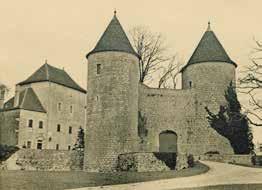


d’Andelot on six subsequent visits through 1937. Pierre edging during his last visit in 1937.
Église St. Sulpice with the grave of Nicole Charlotte Marie Louise Le Dée de Rencourt (1743–1784), the first wife of Pierre Samuel du Pont de Nemours (1739–1817) and great-great grandmother of P.S. du Pont.
The tourists spent the night in Fontainebleau then headed for Paris to start the garden trip. It was one of the first of its kind for Americans: a Garden Club of America 14-day tour of French gardens, with a subscription price for 20 participants with guide at $318.47 each, presumably excluding hotel expenses and meals. The Garden Club of America was only 12 years old, transatlantic travel was expensive and time consuming, and most privately owned châteaux were not open to the public. But after World War I, Americans were welcomed in France, and a well-heeled tour group was perhaps something of a novelty for French aristocracy.
Among those the participants met were the celebrated designer/restorer of classic French gardens, Achille Duchêne (1866–1947); Dr. and Mme. Carvallo of Villandry; Marquis and Marquise de Ganay of Courances; M. and Mme. Edme Sommier of Vaux-le-Vicomte; and Claude Monet. The trip was well documented. Alice and Pierre collected postcards and Aileen du
Pont took snapshots of some of the places visited. From all this it is possible to reconstruct the garden trip in detail. The following very select synopsis is compiled from three written accounts, by participants Authur Lisle of Connecticut, Charlotte Toland of Philadelphia, and Alice herself.
The trip began on Saturday, July 18, with 14 women and seven men traveling in six cars with luggage strapped overhead. The districts visited were those immediately around Paris and the gardens of the lower Seine and Normandy to the edge of Brittany and then to the Loire through Touraine, returning to Paris via Fontainebleau and Versailles. Charlotte Toland recounted: We were received at 27 by their owners in person and shown over their houses and gardens, and at 13 by head servants or butlers. Afternoon tea had been arranged for us every day at one of them and once or twice, an extra or unexpected “tea” was somewhat difficult to manage and we had to divide our party. Often in our morning visits there would be a goute “imprevu,” a tray handed of cakes and wine. Afternoon tea was always served, seated around the long dinner table, the tea-pot a mere incident amidst the rich cakes, tarts, pastries, wines and fruit. At only two houses was tea poured by the hostess herself—at
Esclimont by the lovely young Duchesse Bissaccia and at Voisins by the Countess Fels …. Everywhere that we were received, it was with a welcome, an accueil, due, of course, to the kind offices of the “Bien Venues” and to America's part in the war, to which I can scarcely do justice. When we tried to express our remerciments, our “reconnaissances,” it was always “Oh! Mais des Americains et la guerre.” Their families, always their children, often their friends, were present to greet us, and to show and explain their beautiful surroundings. State bedrooms are often downstairs but we were sometimes shown their own, and we were escorted through parks and garden on long, and several times very wet walks. We had a good deal of rain on this trip.
The complete itinerary was, in order: Comtesse de Fels and Madame Ernesta Stern’s gardens in Paris, then the châteaux or gardens of Méry, Villarceaux, Claude Monet, Bizy, Beaumesnil, Anet(†), Condésur-Iton(†), La Ferte-Fresnel(†), Chantereine, Brécy, Balleroy, Harcourt, Sassy, Sourches, Le Lude, Serrant, Cinq Mars, Seilleraye, La Gascherie, Brissac, Montreuil Bellay, Azay-leRideau (*), Ussé, Villandry, Montrésor, Liget (?), Valençay, St. Aignan, Chenonceaux, Langeais (*), Valmer, Menars, Cheverny, Fougères, Mon Repos, Blois (?), Courances, Le Bréau, Champs, Pomponne, Vaux-le-
Above, left to right: Pierre (in a tie) and Alice (holding her hearing aid) pitched in to spruce up the Château
Left: Château d’Andelot after restoration, c. 1930.
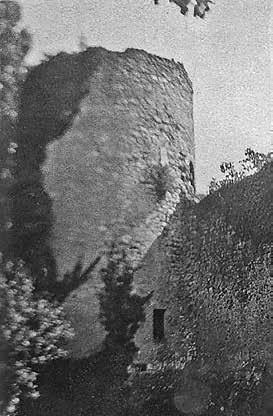
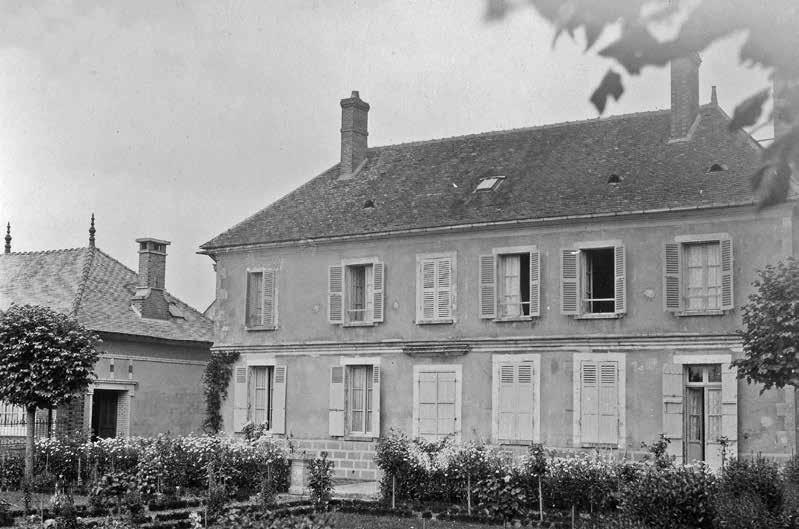
Vicomte, Fontainebleau, Mesnil-Voysin, Bonnelles, Voisins, Wideville, Breteuil, Esclimont, and Versailles. Those marked (†) were visited by half the group including Aileen du Pont while the other half including Pierre and Alice visited Monet, Bizy, and Beaumesnil instead; those marked (*) were not mentioned by Alice but photo postcards are in Pierre’s collection; and those marked (?) were mentioned by others but not by Alice.
One of the most extraordinary gardens was Villandry, the ultimate potager. Villandry shares amazing parallels to Longwood. Spaniard Joachim Carvallo in 1899 married Anne Coleman from Lebanon, PA. Anne was a freshman at Bryn Mawr College when Alice du Pont was a senior there. Anne’s father and brother were members of the Farmer’s Club (and Anne was an honorary member from birth), to which Pierre belonged; Pierre and Anne’s brother were joint members from 1929 to 1933. It was Anne’s money that allowed the couple to purchase the derelict château in 1906, the same year Pierre du Pont purchased Longwood. Carvallo went on to create his vision of a Renaissance garden based largely on Jacques Androuet du Cerceau’s engraved views of French châteaux and gardens published in 1576 and 1579. Villandry’s three
main areas that the du Ponts would have seen are the elaborate Jardin potager on the lowest level; the Jardin d’ornament on the middle level with Gardens of Love, Crosses, and Music; and the Jardin d’eau on the highest level providing a beautiful reservoir and water source. Henri Carvallo, today’s owner, served on Longwood’s Visiting Committee from 2011 to 2019.
Courances was another great garden, with water as the defining element. Recalled Alice: Marquise de Ganay and her daughter [were] delightful hostesses. The latter took us the entire way around the park. Wonderful trees and vistas with water playing an important part everywhere …. Arthur Lisle rhapsodized, … I have no words to do justice to the beauty of the place. The estate received its name from the water gardens, lakes, pools, cascades and fountains. Water poured into every pool, and there must have been twenty of them, from the heads of stone monsters. Every pool had its fish, trout, black bass and carp.
Five months after the trip, Alice composed a six-page typed essay on French gardens, prepared for a lecture (probably given on February 1, 1926, when she hosted the Garden Club of Wilmington at Longwood) and a rare example of her formal writing style. It sums up her
impressions better than her daily jottings, so excerpts are included here:
In reading over my notes on the French Gardens they seem to me to refer almost entirely to the Chateaux, for gardens, as we in America know and love them, are not those of old time France. These gardens that have come down through generations and cling to their original plan are stiff parterres and borders that edge the entrance courts or follow the lines of terraces. In almost every case the flowers of the borders are scarlet geraniums, magenta or cerise fuchsias, pink begonias and blue ageratum, and to add to the medley of color the border is apt to enclose a parterre of box-bordered beds containing no flowers at all, but filled with broken tile or pebbles in red and blue and black. In only one place, the Chateau de Balleroy, did we see the pink begonia and blue ageratum used alone in border and parterre, and then the effect was really lovely. When we met the Marquis and Marquise de Balleroy it was easy to see that their tastes were distinctly aesthetic, thus explaining the charming color combination. When the French Gardens were modernized and more real planting done the owners used standard flowers of all kinds in a lavish way that is unknown in this country. The Standard roses and fuchsias were wonderful and apparently were grown very easily …. The Comtesse Fels and the Vicomtesse de la Rochefoucauld both
Bois-des-Fossés, the home acquired by Pierre Samuel du Pont de Nemours in 1774, near Chevannes, photographed July 13, 1925.
Du Pont snapshot of the Vauvert Tower at Châtillon-Coligny, July 13, 1925. Longwood’s Chimes Tower was likely inspired by the Vauvert Tower; both overlook water and adjoin a wall.

slight bend beyond the statue, adding up to a total of 3,800 feet. Longwood’s Main Fountain Garden allée was about 1,110 feet long in Pierre’s time, today about 1,280 feet. Postcard in the collection of P.S. du Pont.
showed us their gardens and apparently were deeply interested in them. It was only at tea in the latter’s home, the Chateau d’Esclimont, that the flowers on the table were arranged in perfection for their full decorative value, as we are instructed to do by the Judges in the competition of Artistic Arrangements staged by the Garden Club of America. Here as at all the chateaux where tea was served the table was large enough to seat twenty-five or thirty and it was decorated with marvelous pieces of old blue Canton China. Two of the large bowls were filled with dainty white hydrangeas smaller and unlike any that I’ve ever seen in this country. Often there were no flowers at all on the tea tables but formal arrangements of mirrors and porcelains. But if the flower gardens of the old Chateaux seemed inadequate the parks were glorious and the trees magnificent. Allées of trees, each one a lovely vista for a fountain or piece of statuary, are as common as hedges in this country and show the permanence of the French country place and the superiority of French climate for the long life of trees. Those we saw were planted hundreds of years ago and will last for many centuries to come. The entrance avenue of
Menars was so wonderful that I will show you a picture of it.
If none of you have seen Claude Monet’s garden it may be hard for you to believe that its perfect beauty and its seeming seclusion lie on two sides of a railroad track. The first garden, that slopes down in front of the house, is a succession of beds and arbors filled with and covered over with all kinds of the gayest summer flowers. The most striking and unusual to us were the penstemon. One variety, the Southgate Gem, is a brilliant cherry-red and the flowers are as large as snapdragon. These I hope I can show you at Longwood next spring. Beyond the railroad track lies a garden that seems impossible of accomplishment outside of a large domain, far from the haunts of man. Here are lofty trees and rushing brooks and a large pool or lake covered with the loveliest pond lilies of all colors shimmering in the glistening sunshine, and with the banks of the lake blue with agapanthus set about with ferns. Claude Monet himself, a picturesque old man with his eyesight almost gone, showed us his garden and was helped in so doing by Mr. Butler another artist. The latter’s costume could not possibly have been
seen outside of France or an artist’s home. He wore a blue-green waistcoat, bright blue khaki trousers, a yellow suede coat, a nondescript hat and bright red tie.
As a fitting ending to my very inadequate description of the French Gardens I must speak of those most formal and imposing ones that owe their impressiveness to the magnificent use of water in a series of immense fountains, namely Champs, Pomponne and Vaux le Vicomte; unlike Versailles where the government’s lack of money has prevented a too thorough upkeep and has permitted both gardens and fountains to show the mellowing effects of time, these gardens, that have been restored by the lavish use of money made in sugar and tobacco, look almost too perfectly kept. They look so new that it is hard to believe that the restorations have been made absolutely in accordance with the plans that date back to the time of Louis XIV. At Vaux le Vicomte and [Pomponne] the chateaux face hillsides down which the fountains pour their water in stone work channels of every variety of shape and size into basins equally diversified and in both places the water comes from an underground reservoir at the top of the hill. At
Alice noted at Menars this very unusual double avenue of trees [lindens] about twice as long as Longwood arching over and with a glimpse of a statue at the end. The allée shown here is about 1,100 feet long, and it continues on after a



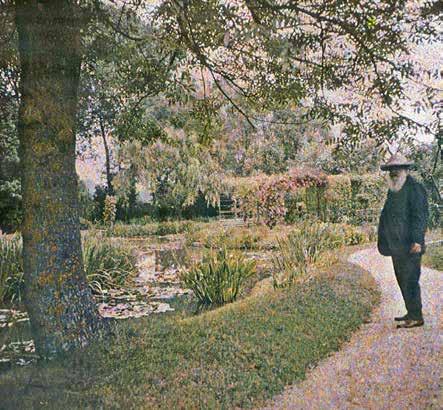
Above: Another view of Claude Monet in his water garden, c. 1925.
Right: Claude Monet (1840–1926) in his water garden, c. 1917.
Below: Monet’s house and flower garden at Giverny, 1979. Photos by Colvin Randall.
Claude Monet’s Garden


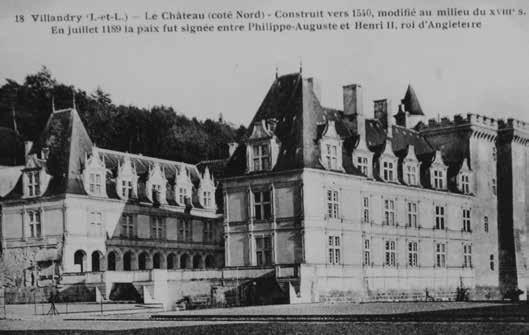
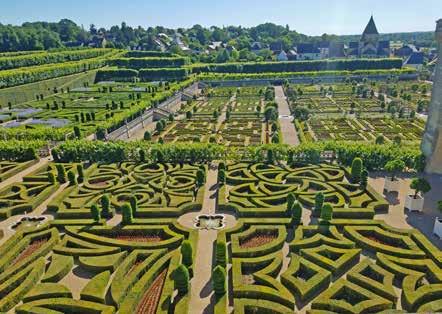

Above: Villandry, the ornamental Garden of Love (left, photo by Colvin Randall, 2018) overlooks the Potager (right, photo by Ed Broadbent, 2013).
Above: Pierre and Alice du Pont visited Villandry on July 24, 1925, and saved these three postcards.

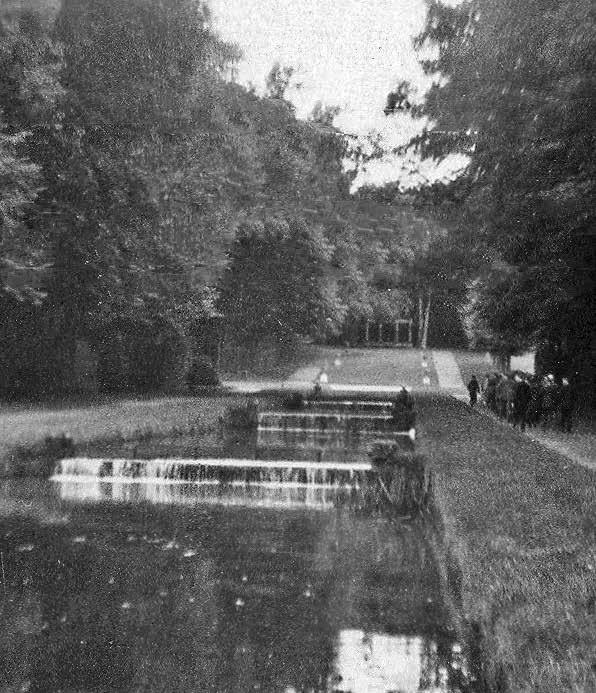
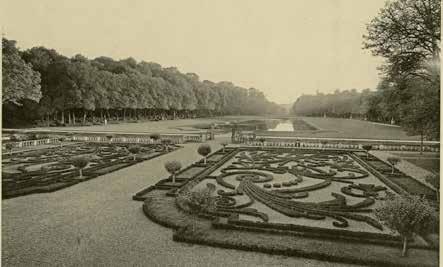



Above left: Courances, July 29, 1925. The tour group is shown to the right of the cascade known as Les Nappes
Above right: Courances today, restored after World War II. This view opened a memorable TV ad for the fragrance Chanel No. 5 in 1985.
Photo by Colvin Randall.
Above, left to right: Two of the sculptures spouting at Courances. Photos (left) by Colvin Randall and (right) by Troy Sellers.
Above left: Courances photographed by Frances Benjamin Johnston in the summer of 1925. Similar bollards and chains were installed by Pierre du Pont along what is now Paulownia Drive.
Above right: Parterre view from the other side of the château, from Prosper Péan, Jardins de France, 1925.
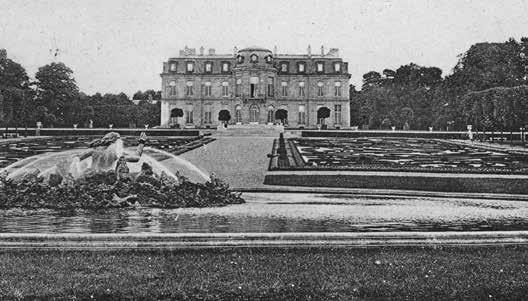

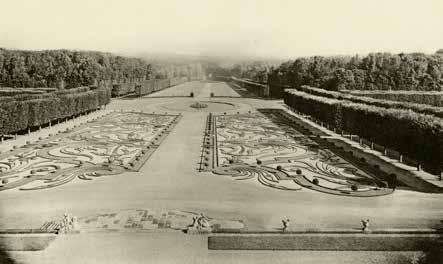

Vaux le Vicomte where the reservoir only holds enough slowly [accumulating] water to allow the fountains to play for four hours a week nearly the whole week’s supply was exhausted by our visit. Some idea of the size of the water basins may be given by telling you we crossed one that was almost a lake, on a little ferry boat. This was in order to walk on up the hill and get the view from the top. As words seem futile in describing what I saw I can only hope that some day you may all see the originals as we did.
Alice noted about Champs, Comte Cahen d’Anvers home … lunched in drawing room on picnic lunch. All has been restored according to the original plans and the garden slopes down in front of the house in broad lawns and flower beds and an occasional fountain, all surrounded with clipped alleys and wonderful trees with rolling hills in the background. One single spray fountain about forty feet high seen between even higher square clipped trees is the gem of the place and a lattice pergola or summer house effect most delightful.* Arthur Lisle thought it was just
as wonderful as the others and in some way more so, containing allées, fountains and statuary. Charlotte Toland noted that six men do nothing but clip [trees] for six months of the year. Mr. du Pont wondered that the work could be accomplished in that time.
At Pomponne they were, said Alice, expected for lunch but did not know it. Mme Dumez old and charming and with guests in the house who did the tours of both house and garden. Beautifully kept garden with fountains one above the other, basins, frogs etc, all of heavy stone. Two reservoirs with springs feeding them provided the water which flowed in real torrents. Lowest basin of all particularly pleasing.* Costs $200,000 a year to keep up. Arthur Lisle wrote, This had a most gorgeous garden of the Italian type with more than one hundred fountains. Clipped box and yew and laurel. Really the most gorgeous we had seen up to this time. It was so wonderful that it hurt, in that we hated to leave it.
At Vaux-le-Vicomte, we had been told that when we had seen this we had seen the finest, and I feel that it was, recalled Lisle. Alice
noted that M. Sommier was a rich sugar man. Gardens laid out by Le Notre before he went to Versailles. When bought by [the] present owners’ [father,] enough of the original left to restore it without books. A wonderful series of pools, lakes, basins and fountains all rising to a gigantic statue of Neptune [actually Hercules] beneath which is [a] reservoir filled by springs and containing a 4 hour supply. 2/3 of [a] mile from house to statue and a boat crossing of pond. Charlotte Toland recalled, We were received there by M. and Mme. [Edme] Sommier. She is the daughter of M. Casimir-Perier, so young and pretty in an apricot frock, and he rather English looking, fair, with a glass in one eye. We had lost our way and were late and les ‘Grandes Eaux’ had been turned on for us at four o’clock. So it was rather a relief to find no long seated tea table, and tea was served by the butler from a small buffet. Then we walked through the stately rooms and out onto terraces, where tapisseries and flowers, led to flights of steps, where pools and fountains, and cascades overflowing into basins, and more fountains and pools, brought
Bottom row: Champs, 1983. Photos by Colvin Randall.
Top left: Postcard of Champs in the collection of P.S. du Pont.
Top right: The parterre, from Prosper Péan, Jardins de France, 1925.
*Alice confused Champs with Pomponne, so her descriptions are correctly switched here.
Right: Snapshot of Pomponne, July 29, 1925. The garden was reconstructed by the Dumez family in the late 19th century based on engravings.
Below, left to right: Close-ups of cascade and “cupids and frogs,” July 29, 1925.

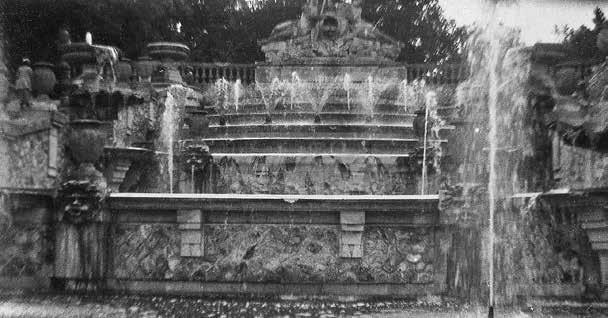


Above: Pomponne cascade, from Girardin, Maisons de plaisance francaises, parcs et jardins, l'Ile de France, 1920.

Above right: Snapshot view back to château, July 29, 1925.
Right: View from top of cascade back to château, from Girardin. Today, Pomponne houses a riot control division of the French National Police and the garden is in ruins but the dry fountain basins still exist and can be seen on Google Maps at “Rue Louis Dreux, Pomponne France.”


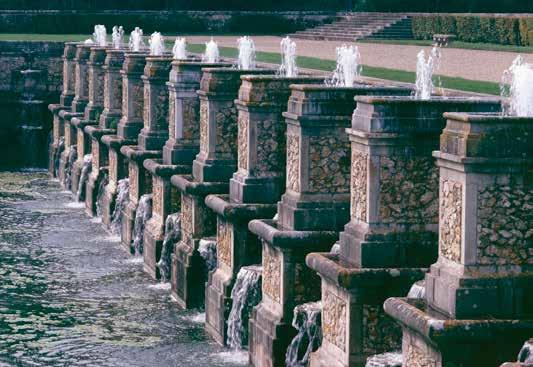
Above: Vaux-le-Vicomte photographed by Frances Benjamin Johnston in summer 1925.
Right: An enormous wall of cascading fountains is surprisingly revealed as visitors proceed from the château to the distant hillside.
Photo by Colvin Randall.

Below: View from the cupola, 2018. In 2019, the boxwood in the parterre was replaced by simplified, artistic metal scrolls due to blight while options for replanting are explored. Photo by Colvin Randall.
Hercules, newly gilded, is the distant focal point of the vista shown below. Photo by


Naomi McCafferty, 2018.
Right: Vaux-le-Vicomte showing La Gerbe spouting.
Photo by Colvin Randall.
us to a wide stretch which one crossed in a big flat boat, with a pulley, and on the far side, the statues and steps and fountains and pools and cascades, and basins, mount upward, till one reaches the biggest and most magnificent, the fountain of the Couronne [actually named La Gerbe]. The reservoir is underground at the top of the hill. We thought it far finer than Versailles, for 'though on a scale of grandeur, (there are 375 hectares of it!) it can all be seen at once, in immense and comprehensive beauty. We walked back to the chateau through an allée—the hall had a novel sundial, long streaks with numbers radiated from the large south door all across the marble floor, and a ring at the top of the door provided the spot which marked the hours. A fight between a pet cat and dog enlivened our departure. A Longwood connection today is that Alexandre de Vogüé, the great-greatnephew of Edme Sommier and present owner
of Vaux with his two brothers, was on Longwood’s Visiting Committee from 2020 to 2025.
Following the conclusion of the Garden Club of America trip in the town of Versailles on Friday, July 31, Pierre and his cohorts arrived in Paris on Saturday, August 1. The next day they went back to Versailles to see the fountains, probably the first time Pierre had ever seen them in operation because his previous visits were always on weekdays or during the winter. One 1925 guidebook, Louis Blouin’s Versailles, says: There remain but 610 jets of water in the gardens, while they numbered 1400 in the XVIIth century. The ‘Grandes Eaux’, which constitute an admirable spectacle, play on certain Sundays in the summer …. They last one hour only … offering a sight unparalleled in the world.
Versailles

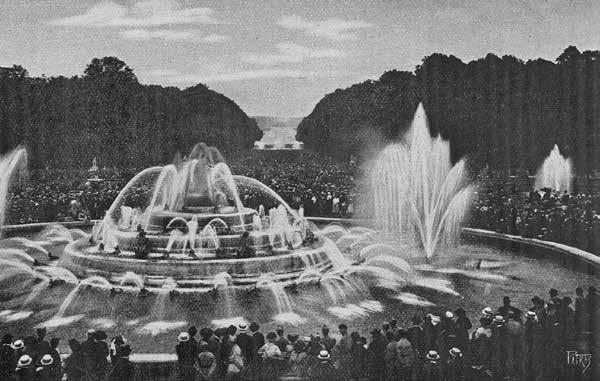
In the four days in Paris before beginning the Garden Club trip, or in the three days between its conclusion and their departure for home, it is likely that Pierre and Alice visited the “must-see” world’s fair that year, the Exposition Internationale des Arts Décoratifs et Industriels Modernes held April to October 1925. It was staged on the esplanade between the Invalides and the Grand and Petit Palais, not far from where Pierre had enjoyed the 1889 Exposition Universelle as a teenager. This new fair was the event for which the term Art Deco was later coined by shortening the title words Arts Décoratifs. Garden design was at a crossroads in France. Pierre and Alice du Pont had just been immersed in the style régulier, the jardin à la française as reinvigorated in the late 19th and early 20th centuries by father Henri and
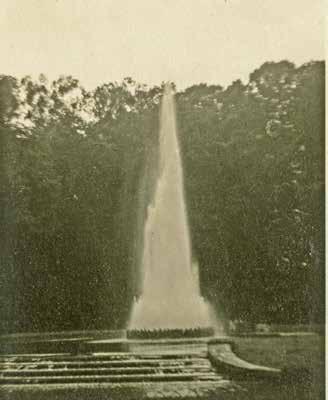

Above, left to right: Du Pont snapshots of the Encelade and the Obélisque fountains at Versailles, probably August 2, 1925.
Below: Photographs of two of Versailles’ largest fountain groups, from Blouin’s 1925 Versailles guidebook.
son Achille Duchêne. But that style was no longer relevant to the Roaring Twenties, so the fair exhibited a new inventiveness in garden design that was eye catching but, it turned out, fleeting. One wonders what Pierre and Alice thought of these new designs, especially the fountains. Regardless, on their return from France, Pierre immediately ramped up construction for the (Italian) Water Garden and, a year later, the expanded Open Air Theatre. Both projects were major fountain installations, and it is certain that his exposure to classic French gardens and their waterworks influenced him (such as in considering hilltop reservoirs), not only in these two additions but also for the Main Fountains five years later.
So did the du Ponts actually take tea with Monet when visiting him at Giverny? No one knows for sure—but it’s a nice thought!
The
Fountain
garnered much attention both day and night at the 1925 Expo.


Left: 1925 Map of the gardens, from Blouin’s Guide of Versailles and Trianon Palaces. The fountain viewing route (dotted line) starts in the center right and proceeds counter-clockwise, whereas Louis XIV recommended to proceed in a clockwise direction, ending near the Neptune Basin (top right). Fountains run today between two and three hours; it would have been nearly impossible to see everything in only an hour as indicated in 1925.
Right:
Lalique
of glass
For the Love of Books
A gift to our new Library in loving memory of Longwood Volunteer Mary Zwiebel.
By Katie Mobley

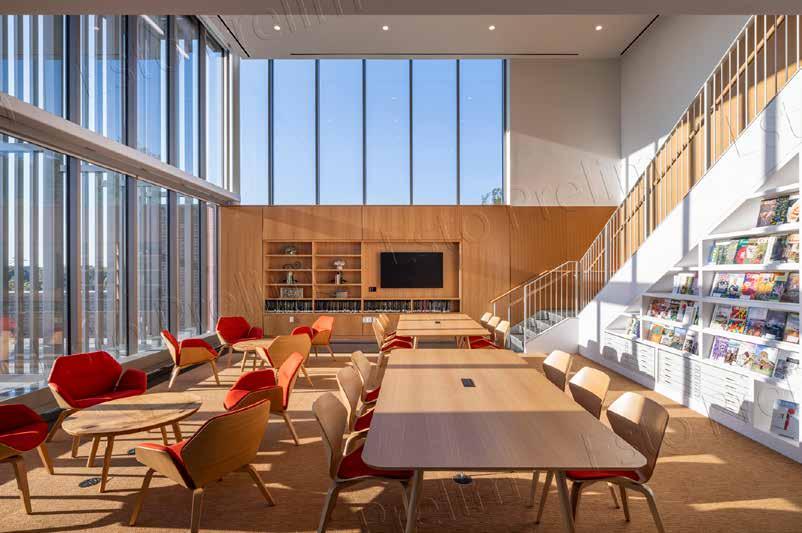

Longwood Library seating area.
Photo by Albert Vecerka.

A


“At Longwood, so very much is about legacy, community, and family. The Zwiebels are members of the Longwood family and all they have done for Longwood is truly immeasurable—as is our gratitude to them.”
– Longwood President and Chief Executive Officer Paul B. Redman
Fred Zwiebel visits the new Library in The Grove, with Longwood President and Chief Executive Officer Paul B. Redman. Photo by William Hill.
Mary Zwiebel, pictured in 2019.
Photo by William Hill.
the Longwood Library.
Photo by Hank Davis.
“I wanted my gift to Longwood Gardens to honor my late wife Mary and to further the great work that is ongoing for many generations of people to come, enjoy, and be part of Longwood. I’m happy to see that this is happening.”
– Fred Zwiebel
Longwood is a place of legacy, and a place of love, for so many, and we are honored that it is such a place for former longtime volunteer Fred Zwiebel. Inspired by his and his late wife Mary’s multi-decade and multi-faceted relationship with our Gardens, and in honor of Mary, Fred recently made a generous $200,000 gift to our Library, which means so much to so many.
Fred and Mary were married for more than 70 years and first visited Longwood on their 38th wedding anniversary—a request Mary had made after learning about Longwood from Fred’s stepmother. Visiting from New Jersey, it took them one day of exploring our Gardens, enjoying a meal here, and joining in on an organ performance to decide that this was the area, close to Longwood, where they wanted to retire. And the Zwiebels did just that. They put their brand-new property— where they had previously planned to build a home and retire—on the market and moved to Kennett Square.
Once in the area, the Zwiebels became frequent Longwood guests, engaging in many classes, concerts, and other Longwood programs. After seven years of many, many visits, they became volunteers. Fred dedicated his talents and interests to many areas at Longwood: as a volunteer with the horticulture team, a pipe organ docent, and a volunteer photographer. During his many years with Longwood, Fred contributed more than 3,000 photographs to Longwood’s Digital Gallery—many of which are still used today.
Inspired by her career spent in publishing, Mary focused her efforts on Longwood’s
Library, volunteering for 21 years until the age of 88, prior to her passing in 2023. Mary was an invaluable member of the Library team, giving more than 8,400 hours of her time and sharing her trademark sense of humor, her love of reading, and her delight in chatting with each and every person who came into the Library. “It was her joy and honor to put in more hours than any other volunteer at the time,” shares Fred. “She absolutely thrived on it.”
In 2024, Fred approached Longwood President and Chief Executive Officer Paul. B. Redman with his wish to make a significant contribution in Mary’s memory to Longwood’s new Library. Recently opened as part of Longwood Reimagined, the 1,500-square-foot Library is located in The Grove—a central hub for our community of staff, students, and volunteers, and a place of learning for all.
For generations, our staff, students, and volunteers have turned to this valuable resource with questions related to horticulture, botany, arts, sciences, and Longwood’s history. Founded in 1953 to house founder Pierre S. du Pont’s collection of horticultural, botanical, and related works, the Library has since grown into a working collection of approximately 30,000 books and eBooks, including rare and special collections. These collections consist of scarce, fragile, or unique published materials relating to design styles strongly evident within the Gardens; significant publications and botanical illustrations of the taxa represented in our plant collections; American horticultural history; and the history and development of the

Longwood land, among many other topics.
Our archives collection features both institutional records and personal papers that provide a comprehensive history of Longwood’s growth and development. The collections contain archival material and manuscripts from photographs to architectural plans, maps to illustrations.
Fred’s gift supports the conservation of rare books and archival objects, as well as the digitization of our hundreds of thousands of photography slides— which will help bring spans of our photographic history to life for us to learn from and honor.
This last September, Fred visited the Library with his two daughters, Sharon Mathusa and Debi Heptig. They toured the new space and visited with Longwood staff—including Library Manager Gillian Hayward, who had the pleasure of working with Mary and becoming her close friend during Mary’s time as a volunteer. Together, they shared fond memories about Mary’s time at Longwood and what the Gardens have meant to their family throughout the years. It was a privilege to welcome them, just as it’s been a privilege to be a part of their story since their first visit here, many years ago.
We are all deeply grateful to Fred for his thoughtful and profound gift in support of our Library, as well as all he and Mary have done for our Gardens for the last several decades. Not only will his generosity make a true and measurable difference for our rare book and photography collections, but also means so very much to all of us who had the pleasure of knowing, and loving, Mary.
Much of Longwood’s programming and collections are supported by gifts of all sizes from individuals like Fred. If you would like to learn more about how you can directly support the Library, or any of our collections or programs, please contact Director of Major and Planned Gifts Rebecca Ackerman at rackerman@longwoodgardens.org.
“… Longwood’s mission of bringing joy and inspiration to everyone through the beauty of nature, conservation, and learning is supported by contributions of all sizes from across the greater Longwood community. Fred’s generous and thoughtful gift is the perfect example of such support and will make such a difference for a part of Longwood that Mary so beautifully treasured. We are so grateful for all the Zwiebel family has done for our Gardens.”
– Longwood Chief Philanthropy Officer Rachel McCausland


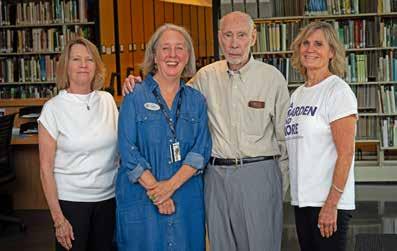



the
Above, top: Mary Zwiebel and Library Manager Gillian Hayward at Mary’s retirement party, in celebration of her 21 years of service as a Longwood Volunteer.
Opposite: Fred Zwiebel at the Longwood Library.
Photo by William Hill.
Above, bottom: Fred Zwiebel pictured in the Organ Museum where he served as a pipe organ docent for many years. Photo by Bob Doerr.
Above, top to bottom: Fred Zwiebel (center right) and his two daughters, Sharon Mathusa (far left) and Debi Heptig (far right), visited Longwood’s new Library in late September. Here, they’re pictured with Longwood Library Manager Gillian Hayward,
who had
pleasure of working with—and becoming a close friend of—Mary Zwiebel during Mary’s time as a volunteer; Longwood’s new Library, opened as part of Longwood Reimagined
Longwood Chimes
No. 311 Summer 2025
Front Cover
Main Fountain Garden Basketweave fountain in suspended animation.
Photo by Daniel Traub.
Back Cover
Tropical night-flowering waterlily in the Waterlily Court. Photo by Holden Barnes.
Inside Front and Back Cover
Main Fountain Garden scupper (inside front) and jet (inside back). Photos by Daniel Traub.
Editorial Board
Rebecca Ackerman
Jourdan Cole
Nick D’Addezio
Patricia Evans
Steve Fenton
Timothy Gould
Julie Landgrebe
Katie Mobley
Colvin Randall
Kate Santos, Ph.D.
Kelli Stewart
James S. Sutton
Contributors This Issue
Longwood Staff and Volunteer Contributors
Kristina Aguilar
Plant Collection
Information Manager
Holden Barnes
Volunteer Photographer
Hank Davis
Volunteer Photographer
Bob Doerr
Volunteer Photographer
Carol Gross
Multimedia Designer
William Hill
Volunteer Photographer
Katie Testa
Communications Associate
David Ward
Volunteer Photographer
Peter Zale, Ph.D.
Director of Conservation
Horticulture & Collections
Other Contributors
Nolan Pelletier
Illustrator
Meghan Newberry
Photographer
Lynn Schuessler
Copyeditor
Daniel Traub
Photographer
Albert Vecerka
Photographer
Distribution
Longwood Chimes is mailed to Longwood Gardens Staff, Retirees, Volunteers, Gardens Preferred and Premium Level Members, and Innovators and is available electronically to all Longwood Gardens Members via longwoodgardens.org.
Longwood Chimes is produced twice annually by and for Longwood Gardens, Inc.
Contact
As we went to print, every effort was made to ensure the accuracy of all information contained within this publication. Contact us at chimes@longwoodgardens.org.
Support
To learn more about how you can support Longwood’s One Water journey, please contact Rebecca Ackerman, Director of Major and Planned Gifts, at rackerman@longwoodgardens. org. Together, we can ensure water continues to nourish both our Gardens and our shared future.
© 2025 Longwood Gardens. All rights reserved.

“Water
– Leonardo da Vinci
